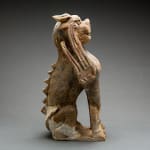Tang Sculpture of a Spirit Guardian, 618 CE - 907 CE
Terracotta
35.6 x 15.2 cm
14 x 6 in
14 x 6 in
H.516
Further images
As new philosophical and religious strands penetrated the thought system of early China, the subject matter of tomb objects and tomb patterns changed. The past practice of entombing elite members...
As new philosophical and religious strands penetrated the thought system of early China, the subject matter of tomb objects and tomb patterns changed. The past practice of entombing elite members of society with earthenware objects continued throughout the early and middle Tang period, but the earlier emphasis placed on recreating daily life shifted to flaunting status and excess. Tombs were no longer "underground houses," but became a landscape with murals depicting the palaces, gardens, and open countryside in which the nobles passed their lives. Buddhist Guardian beings, including both supernatural humans and animals, reflected this trend toward elaborateness as they functioned to provide protection, links with the spirit world, and status. It is no doubt this guardian figure served that purpose for its master. Its ferociousness is felt through the sight and sound of its growl, triggered by the approach of danger; it was believed that this beast took life during the depths of night or at moments of threat. Equipped with wings, cloven hooves, a long spiny tail that continued up its back, and a snout, the guardian animal was a coming together of the best features of different animals: lion, horse, and dragon. This guardian beast crouches in a lion-like stance, thrusting its chest forward and drawing back its head. Although once painted in bright colors, the hardship of years of underground burial have caused the red, blue, and white coatings to fade. This guardian figure surely captures the vitality and spirit of supernatural beings in its awesome form. Created during one of the greatest periods in Chinese history, it reflects the artistic vitality of the time and provides us with a unique glimpse into the luxurious and sophisticated world of contemporary upper class life.
Literature
V17







